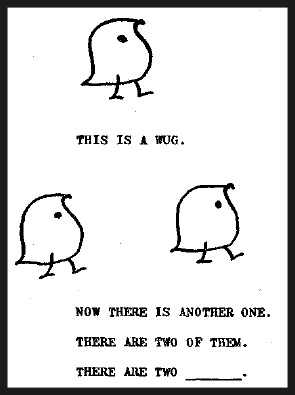Researchers at the University’s Child Language Study Centre showed children, aged two, sentences containing made-up verbs, such as ‘the rabbit is glorping the duck’, and asked them to match the sentence with a cartoon picture. They found that even the youngest two-year-old could identify the correct image with the correct sentence, more often than would be expected by chance.
The use of made-up words is interesting as it's a feature of child language research from as far back as 1958 when Jean Berko Gleason's wug test revealed that children are able to apply plural rules to words they've never heard before.
Child Language researcher, Dedre Gentner also used made-up words in her interestingly titled 1978 paper What Looks Like a Jiggy but Acts Like a Zimbo (pdf link).
While the appearance of made-up words in reading tests for primary school children has upset and angered many reading experts, their use in child language experiments is helpful because they can shed light on how patterns and rules are internalised by children and applied to examples of language they haven't heard before, perhaps suggesting that there's an innate capacity for language acquisition (or at least, some sort of generalised puzzle-solving equipment) in all children.


